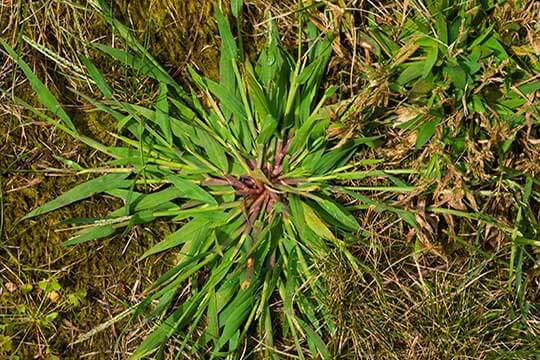The bluegrass billbug is a small insect, about 10 mm long, with a color that ranges from gray to black to reddish. Its most distinctive feature is a long, curved snout. Its larva looks similar to a white grub, but is much smaller (around 5 mm), legless, and has a brown head.
The life cycle of the bluegrass billbug
- Overwintering: The adult survives the winter under plant debris.
- Spring reappearance: By April, adults become visible around home foundations and on walkways, feeding on grass blades.
- Egg-laying: Females lay eggs in June.
- Larval development: After hatching, larvae burrow into the soil and begin feeding on grass roots.
- Pupation: In July, the larvae pupate and turn into adults by August.
- Winter Prep: In fall, they seek shelter for the winter.
One unusual behavior of this insect is its ability to play dead—it curls up its legs under its body when threatened.
Damage Caused by Billbugs
Damage from billbugs can be significant and often resembles that caused by white grubs. While adults do cause some harm, the majority of the damage is done by larvae.
Signs of Billbug Damage:
- Yellowing patches that spread quickly across the lawn.
- These patches eventually turn white and lead to turf death.
- The most severe damage occurs in June and July when larvae are actively feeding on roots.
Don’t confuse it with drought stress!
During summer, drought-stressed lawns can look similar to billbug-infested ones.
A quick test: If heavy watering makes your lawn green up again, the issue was likely just a lack of water.
Control and treatment
There are two key windows for treating billbugs, depending on their life stage:
- May–June and August–September: Target the adults to prevent them from laying eggs.
- July–August: This is the best time to eliminate larvae and prevent major turf damage.
Prevention: better safe than sorry!
Billbugs thrive in lawns with thick thatch layers and compacted, poorly aerated soil. To reduce the risk of infestation:
- Aerate the soil to improve water penetration.
- Dethatch your lawn to remove excess organic matter on the surface and make the environment less inviting for pests.
If you notice signs of lawn deterioration, act quickly to determine whether it’s due to water stress or a billbug infestation. With the right prevention and control strategies, you can minimize damage and keep your lawn healthy all season long.
Concerned about your lawn? Don’t hesitate to contact your Nutrite Expert today!





